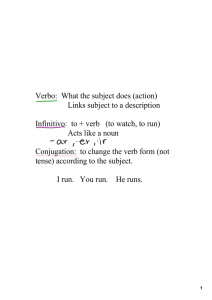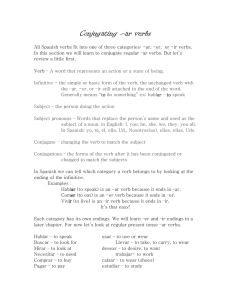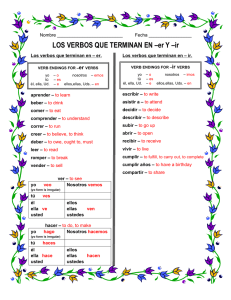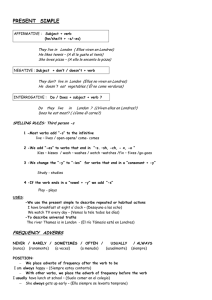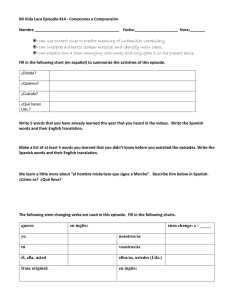yo hablo
Anuncio
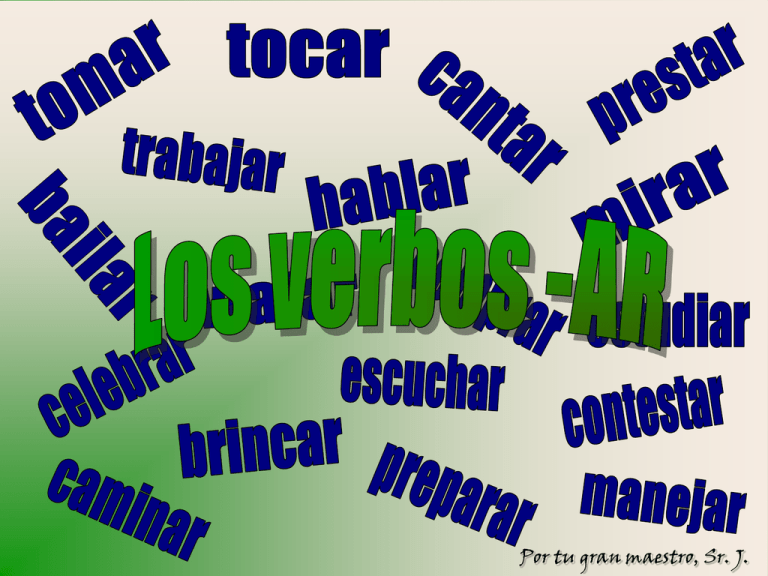
Por tu gran maestro, Sr. J. There are three “kinds”, or “types” or verbs in Spanish. They are: -AR verbs -ER verbs -IR verbs When you see a Spanish word that ends in one of these three letter combinations, it is almost always a verb*. *-There are some nouns that end in these letters, but they would have an ‘el’, ‘la’, ‘los’, ‘las’ in front of them, i.e. “el lugar” = “place” We will need to learn how to use verbs in Spanish so we can communicate our ideas. We’ll start with how to use –AR verbs. First, we will need to know the –AR verb ‘endings’ (present tense). These endings are used to show “who” is doing the action (remember, verbs are action words). They are: yo tú él/ella usted -o -as -a -a nosotros/as -amos ellos/as -an ustedes -an (Uds.) (Ud.) Notice that each ending is paired with a specific subject or subjects. They cannot be mixed and matched. Here’s how we use these endings: ‘Hablar’ means ‘to talk’. If you wanted to say… “I talk” … for example, you might think you would say… “yo hablar” …but not quite. Here’s how to do it: Step One: Write down the subject and the verb. Step Two: Remove the “ar” from the verb. yo hablo hablar Step Three: Add your new ending, making sure it ‘matches’ the subject. So… “yo hablo” …means… “I talk” … in Spanish. Here’s what the verb “hablar” would look like in all 5 forms: yo hablo = I talk/I am talking tú hablas = you talk/you are talking él habla = he talks/he is talking ella habla = she talks/she is talking usted (Ud.) habla = you talk/you are talking nosotros/as hablamos = we talk/we are talking ellos/as hablan = they talk/they are talking ustedes (Uds.) hablan = you (all) talk/you (all) are talking The same would be done with all –AR verbs in the present tense: nadar = to swim yo nado tú nadas cantar = to sing yo canto tú cantas él/ella canta él/ella nada caminar = to walk nosotros/as nadamos yo camino ellos/as nadan tú caminas Uds. nadan él/ella camina nosotros/as cantamos nosotros/as caminamos ellos/as cantan ellos/as caminan Uds. cantan Uds. caminan Let’s compare an -AR verb to the two verbs you are already familiar with. Look for patterns in the words: ser = to be tener = to have hablar = to talk yo soy yo tengo yo hablo tú eres tú tienes tú hablas él/ella es él/ella tiene él/ella habla nosotros/as somos nosotros/as tenemos nosotros/as hablamos ellos/as son ellos/as tienen ellos/as hablan Uds. son Uds. tienen Uds. hablan DO YOU HOW SEE ABOUT THE PATTERNS? NOW? Let’s see an –AR verb in action Yo bailo. bailar = to dance “I dance.” -or- “I am dancing.” Tú bailas. “You dance.” -or- “You are dancing.” Él baila. “He dances.” -or- “He is dancing.” Ella baila. “She dances.” -or- “She is dancing.” Nosotros bailamos. “We dance.” -or- “We are dancing.” Nosotras bailamos. “We dance.” -or- “We are dancing.” Ellos bailan. “They dance.” -or- “They are dancing.” Ellos bailan. “They dance.” -or- “They are dancing.” Ellas bailan. “They dance.” -or- “They are dancing.” Uds. bailan locamente. “You (all) dance crazy.” -or- “You (all) are dancing crazy.” Let’s watch one more video that reviews –AR verbs URL: http://www.youtube.com/watch?v=4Ex3k3yKjYk ¿Qué aprendiste tú? Continúa Read each statement and choose the correct form of the –AR verb. Click on your choice. 1. Nosotros _____ por el parque. camino caminamos camina 2. Ellos _____ en la piscina. nadan nadas nadamos 3. Yo _____ la televisión. miramos miran miro 4. Mis primos _____ a México. viajamos viajas viajan trabajo trabaja trabajas 6. Mi hermano y yo _____ en el coro. canta cantamos canto 7. Tú no _____ mucho. Mala idea. estudias estudiamos estudian 8. Yo no _____ bien . dibujo dibujas dibuja 9. Ella _____ la flauta. tocan tocas toca 5. Eduardo _____ en Best Buy. There are three “kinds”, or “types” or verbs in Spanish: -AR, -ER, and -IR To use an –AR verb, you need to know the proper “endings”. These endings tell “who” is doing an action. The –AR verb endings for present tense are: -o, -as, -a, -amos, and -an Each ending matches with a specific subject(s): yo=o , tú=as, él/ella/Ud.=a, nosotros/as=amos, and ellos/as/Uds.=an To use an ending, drop the –AR off of the verb first, then add the new ending in its place based on who is doing the action. Ex. hablar habl__ hablo These “endings” work for all –AR verbs in present tense. Knowing this will help you communicate your ideas in Spanish!!! My many thanks to the following RBMS students for their help with the videos in this presentation! Kinsey Simatos, Anna Marchetti, Jordan Steiner, Cassidy Skorija, Eric Campbell, Andrew Costantini, Maria Orzech All Class of 2011
